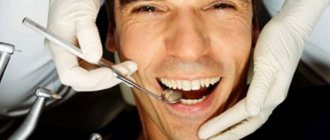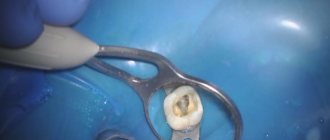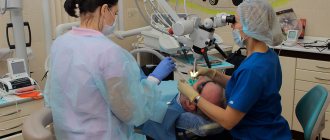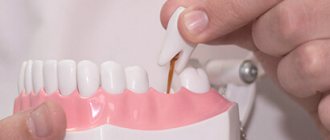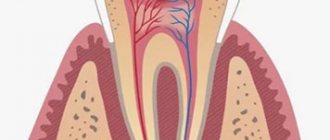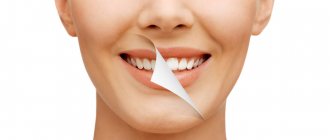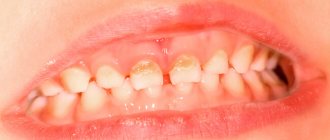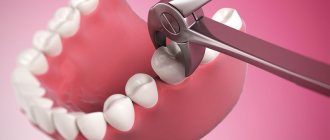The other day we received a question: “I turn white and pale when my tooth starts to hurt. I endure for a long time and yet, 2-3 days before going to the dentist, my heart jumps out of my chest! No matter how much you inspire, no matter how you convince yourself, nothing helps. Valerian and pepper are also powerless... I don’t know what to do, I urgently need to treat pulpitis and caries..."
Our dentists always answer questions from the Internet. But this time they did not immediately find what to answer. We sat in the resident’s room, drank tea, and the discussion resulted in this little note for patients.
The answer to this question is both simple and complex at the same time. But everyone must answer it themselves and overcome their fear. We are not psychologists, but we will try to help a little with this and give some practical advice.
Is it painful to treat tooth decay?
Caries does not hurt to treat. All dentist procedures are a little unpleasant, but do not cause severe pain. An adult patient and a small child can tolerate them.
Initial caries
During the stain stage, the focus is on remineralizing the enamel. This procedure is painless and does not require anesthesia. In case of superficial caries, preparation of the affected tooth tissue and application of a filling will be required. Both procedures are performed under local anesthesia.
Average caries
At this stage, removal of the carious cavity and placement of a filling will be required. Before the procedure, local anesthesia is used, due to which there is no pain.
Deep caries
At the stage of deep caries, peripulpal dentin is affected. The affected area is dissected. The healthy part of the tooth is treated with medications and covered with a filling. All procedures are carried out in 1 – 2 visits to the dentist and under local anesthesia. Patients feel discomfort, but there is no severe pain.
Without anesthesia
Modern anesthetics are very effective. But in rare cases, they can cause a violent allergic reaction in the body, so their use should be avoided. Instead, the patient may be offered dental treatment under sedation - light anesthesia. In addition, the part of the tooth affected by caries can be removed with a laser or using chemically active drugs, which also does not cause severe pain.
On the front teeth
Do not be afraid of treating caries in your front teeth. At any stage of the disease, local anesthesia is used. The doctor’s manipulations are careful and do not violate the aesthetics of the dentition.
Cervical caries
The proximity of the soft tissues of the jaw can make the procedure a little more difficult. But even in this case, it is painless, since it is performed exclusively under local anesthesia.
Important! Modern dentistry and its methods make it possible to cure caries in just one or two visits. And the fear that some patients experience before procedures is nothing more than a lack of positive experience of communication and treatment from an experienced doctor. After all, a good specialist will never allow his patient to suffer from pain and suffer in the dental chair.
Who is contraindicated for anesthesia?
There are three main contraindications to the use of local anesthetics during dental treatment in the clinic:
- Pathologies of the cardiovascular system (stroke and heart attack, after which less than six months have passed).
- Endocrine diseases in the stage of decompensation - thyrotoxicosis, diabetes mellitus. It is recommended that patients of the first and second groups treat caries and other dental diseases only in a hospital.
- Allergic reactions to anesthesia and anesthetic components. In this case, it is recommended to conduct allergy tests and find out which drugs you are allergic to. If it is selective, caries can be treated with an anesthetic injection - but only one to which you are not allergic. If the tests show a reaction to all anesthetics, you will have to treat your teeth without pain relief or look for alternative options. Sometimes the solution for allergy sufferers may be sedation, which puts a person into a state of half-asleep and partially disables reactions. In this state, the pain is felt much less.
Why do we feel pain during caries?
Caries is insidious. Starting completely painlessly, it inevitably progresses. Penetrating deeper, it affects and destroys the hard tissues of the tooth, reaching the border of the pulp - loose connective tissue penetrated by blood vessels and nerves. The pulp has very good innervation and reacts to the slightest external stimuli - cold, heat, sour, salty, sweet, etc. And the deeper the caries penetrates, the thinner the border between the affected tissue and the pulp, which immediately reacts to the irritant with severe pain. It can be short-term, constant, throbbing, aching, and eventually become unbearable.
Important! Healthy teeth don't hurt. If you experience symptoms of pain, contact your dentist immediately. Don't expect the pain to go away on its own. You will simply waste precious time, risk your own health and may lose your tooth.
When is endodontic intervention indicated?
Endodontic treatment is carried out in the following cases:
- Inflammation of the coronal and root pulp - pulpitis. Moreover, the form of the disease can be both acute and chronic.
- Periodontitis.
Inflammation of blood vessels and nerve fibers is observed in complicated forms of caries, with a cracked tooth. Inflammation can also be a consequence of injury.
Are there any contraindications for this procedure?
Like any dental procedure, endodontics is contraindicated in a number of cases:
- Vertical incisor fracture.
- Too narrow, impassable dental canals.
- Damage to periodontal tissue.
How caries develops
The main reason for the development of caries is dental plaque. At its core, it is a dense matrix consisting of pathogenic bacteria. The active activity of tiny microorganisms leads to changes in the pH level on the enamel surface. The balance changes towards an acidic environment, which is detrimental to enamel. A focus of demineralization appears on its surface - a harbinger of a destructive process.
The rate of development of the disease depends on many factors - diet, level of oral hygiene, and preventive measures. The disease can develop quite slowly - over 3 - 4 years. Or develop quickly - in 6 - 12 months. If there is a large amount of sugar in the diet or the patient does not take good care of his teeth, then the disease can develop at lightning speed - within 2 - 3 months.
Considering the depth of the pathological process, a distinction is made between uncomplicated and complicated caries. The latter is accompanied by the development of pulpitis (inflammation of the pulp) or periodontitis (inflammation of the periodontium).
In the clinical picture of uncomplicated (or simple) caries, four stages are distinguished.
- Spot stage – indicates foci of enamel demineralization. Painless spots can be inconspicuous - white, or noticeable - slightly dark in color. To treat caries, enamel remineralization is carried out at this stage.
- Superficial caries is the stage at which the spot becomes slightly rough, which indicates the initial stage of enamel damage. At this stage, increased tooth sensitivity may appear. When contacting a dentist, the affected area of the tooth is carefully polished, followed by remineralization and a filling.
- Medium caries - the pathological process involves the enamel and the upper layer of dentin. The affected area is clearly visible on the surface of the tooth and can react painfully to irritants. It is dissected, treated with medications and filled.
- Deep caries - the lesion reaches the pulp boundary, which is accompanied by severe pain. To treat the disease, the damaged part of the tooth is removed and treated with medicinal and remineralizing drugs. After this, a filling is placed.
Thus, in the presence of superficial, medium or deep caries, tissue preparation cannot be avoided. The only difference is how deep the tooth will have to be drilled in order to thoroughly remove the affected area. Therefore, it is better not to delay your visit to the doctor. It is much easier to cure caries at an early stage of the disease.
Main stages of root canal treatment
Treatment of tooth canals is a complex, specific process that includes several successive stages. Below we will consider all stages of the treatment process in detail.
Diagnostics
During the initial visit to the dentist, the doctor will conduct a thorough examination of the patient’s oral cavity and will also prescribe x-rays. An image of the tooth will allow you to assess the condition of the dental canals, see their number, determine the stage of development of the inflammatory process, and also select adequate treatment for a specific clinical case.
Anesthesia
To gain access to the canals of a tooth, the dentist will drill out the coronal part of the tooth to reach the pulp chamber, behind which the canals are located. Both the pulp and the canals are penetrated by nerve fibers and therefore the specialist’s actions can cause some discomfort to the patient. To relieve a person of discomfort, local anesthesia is performed before starting root canal treatment. The drug is selected individually for each patient.
Moisture insulation of the area of the diseased tooth
To prevent pathogenic microorganisms that may be contained in saliva from entering the internal space of the tooth, the area of the diseased tooth is first protected from moisture by covering with a special latex bandage - a rubber dam.
Reaming a tooth
To gain access to the dental canals, the doctor will drill the tooth, removing all tissue affected by caries. The access hole is made either on the chewing surface of the tooth (when treating molars) or on the inside (when treating incisors and canines). After drilling, the doctor will remove either the entire pulp bundle or only part of the tissue affected by the inflammatory process.
Treatment of dental canal cavities
For high-quality treatment of dental canals, a specialized tool is used - files. Before the cleaning process, it is important to obtain detailed information on the structure of the dental canals, as well as their length. To do this, a photograph of the diseased tooth is taken, and a special type of device is used - an apex locator. The dentist will use the files to clean the canal cavities, and then rinse them with an antiseptic solution and treat them with antibacterial agents. During cleaning and antiseptic treatment, the dentist will expand the cavity of the canals, clean and smooth their internal surfaces. Then the cavities of the dental canals are thoroughly dried with paper points.
Next, the doctor puts medicine into the canal cavity, places a temporary filling on the tooth and sends the patient home. After a few days, you should come back to the dentist to evaluate the results of the treatment. If the image shows that the inflammation has been stopped, the canals are filled.
Sealing
Gutta-percha pins are used to fill dental canals. It is important that the dental canal is sealed correctly and efficiently, otherwise a recurrence of inflammation is possible and the tooth cannot be saved. After filling the canals, the crown part of the tooth is restored with a photopolymer filling or orthopedic structures. It will be useful to know that mild pain in the tooth within 14 days after the procedure is considered normal by dentists. Taking painkillers prescribed by your doctor will help eliminate discomfort. However, if the pain does not go away, its character is sharp, and does not subside even after taking anesthetics, you should immediately contact the dentist!
Pain relief methods
Local anesthetics used in modern dentistry are divided into two types - ether and amide drugs.
- Essential drugs:
— Procaine (Novocaine) is the oldest anesthetic (synthesized in 1898) with a wide range of applications, capable of anesthetizing procedures for 30–60 minutes;
— Benzocaine (Anestezin) is a drug discovered in the same 1898, characterized by a short-term effect - up to 20 minutes.
- Amide drugs:
— Lidocaine (Xylocaine) is a more modern drug (invented in 1943), which has a strong anesthetic effect for 75 minutes or more;
— Articaine (Ultracaine) is a very popular drug in modern dentistry, discovered in 1978. It is characterized by a strong analgesic effect and acts immediately after administration for 1 to 5 hours.
When choosing an anesthetic, the patient should take into account the presence of chronic diseases and allergies. For example.
- If you have bronchial asthma or frequent allergy attacks, you should choose medications that do not contain preservatives.
- For diabetes mellitus or thyroid diseases, use medications without vasoconstrictor components.
- For cardiovascular diseases or high blood pressure - drugs with adrenaline (epinephrine).
Important! Before starting treatment, be sure to notify the dentist about the presence of diseases and allergies, so that the specialist has an idea of your health and chooses the right anesthesia.
Will it hurt when injected into the gum?
Very little. You will feel a slight pain when the soft tissue is punctured. To administer the injection, special carpule syringes with the finest needle are used, so the pain is minimal. Prepare for the fact that the drug will be administered for a relatively long time - within 1 minute. Slow administration of the anesthetic is necessary, which makes the procedure painless.
Can anesthesia be used for pregnant women and children?
Can! Modern drugs have an exclusively local effect, which does not extend to the fetus and does not harm the body as a whole. This has been proven by recent studies by European specialists and doctors of the American Dental Association.
Important! You should not delay caries treatment during pregnancy. An affected tooth is a source of serious infection. It can enter the mother's bloodstream and reach the fetus. Its spread can only be stopped by localizing the pathological process and proper treatment.
What symptoms should you consult a doctor for?
A visit to the dentist is a mandatory event that should be carried out annually - 1 - 2 times a year. If you notice the following signs, you should contact the clinic immediately.
- The presence of light or dark spots on the surface of the tooth.
- The appearance of sensitivity to cold, hot, sour, sweet, salty.
- Tooth pain when biting food.
- Minor or severe pain in the tooth.
Important! If caries is detected, do not refuse treatment - this risks the development of serious complications and tooth loss. After it is done, try to follow all the dentist’s recommendations.
What is it – tooth pulpitis?
Pulpitis is a dental term that refers to an inflammatory process that affects the nerve bundle inside the tooth - the pulp. Colloquially, the pulp is often called the nerve of the tooth. Strictly speaking, the pulp is not only nerves, but also small blood vessels, thanks to which a living tooth receives nutrients and necessary microelements. If the pulp is removed (and this often happens during the treatment of pulpitis), the tooth becomes dead and fragile because it does not receive the nutrition necessary for its full functioning and healthy condition.
The inflammatory process in the pulp never occurs on its own - there are always reasons that trigger it. Knowing the reasons why pulpitis appears is necessary and useful; this will make it possible to carry out effective prevention of this dental disease.
Take a short test and calculate the cost of treatment!
Take a short test
Wisdom teeth caries
Wisdom teeth susceptible to caries can be treated or simply removed. The appropriateness of treatment depends on a number of factors - the location of the molar, the stage of the pathological process, the structure (features) of the dentition, possible prosthetics, etc. Therefore, before making a decision, it is better to consult your dentist.
Caries of baby teeth
A child’s baby teeth must be treated. You should not think that since they are temporary, then after they fall out and change, the problems will go away on their own. They won't pass! Neglected caries very quickly leads to the development of childhood pulpitis. And premature loss of a baby tooth often provokes the formation of a malocclusion and can harm the normal formation of tooth buds.
Where is the tooth canal located, how is it structured
Human teeth have almost the same anatomical structure, including three main parts: crown, neck and root. Inside the tooth there is a pulp chamber, from which canals originate and extend all the way to the root. The pulp chamber contains the pulp or nerve of the tooth, which is a bundle of nerve fibers and blood vessels. Nerve fibers and vessels also pass through the entire internal space of the dental canal. The shape of the tooth canals can be either straight or curved, and their number varies depending on the type of tooth. Thus, the canines and incisors of the upper jaw have one canal, the canines and incisors of the lower jaw have two. There may be two or three canals in molars, and the maximum number of canals is observed in wisdom teeth - from three to five. The exact number of dental canals is determined using radiographic examination.
As mentioned above, the shape of the canals can have bends and turns, which complicates the process of their high-quality cleaning and treatment. Meanwhile, when treating canals, it is important to thoroughly clean their internal space - otherwise it will not be possible to stop the inflammatory process and save the diseased tooth.
Complications caused by caries
Untreated caries is a source of infection and a threat to the entire human body. At the local level (in the oral cavity) it causes the development of the following complications.
- Pulpitis is inflammation of the internal tissue of the tooth.
- Periodontitis is inflammation of the periodontium (the tissue that holds the tooth in the alveolus).
- Phlegmon is a purulent inflammation of soft tissues.
- An abscess is an acute purulent inflammation of soft tissues.
- Tooth loss.
Not to mention the fact that the presence of caries spoils the aesthetics of the dentition and is accompanied by bad breath. This alienates others and makes communication difficult.
Important! Carious lesions tend to grow. If at the initial stage it is one small spot, then over time, darkening and noticeable unattractive lesions will spread to neighboring teeth.
Tooth extraction without pain
The main goal of modern dentistry is to preserve the health and beauty of teeth. Healthy, strong teeth are the basis for good digestion, and a snow-white smile is confidence in yourself and your attractiveness. A person with a beautiful smile can charm the interlocutor and win him over in a few minutes, and the absence of bad breath guarantees that the person’s health is all right. Very often, people underestimate regular visits to dental offices. Many people believe that the absence of pain is the main sign of dental health, but in fact, the process of tooth decay has already begun. Due to insufficient care of their teeth, many patients come to the dentist's office for a tooth extraction procedure, which is a last resort. Very often it is simply not possible to restore a tooth, then the patient has to undergo this unpleasant procedure. Modern dentistry, of course, has made great strides forward. That is why in the Zuub.rf network of clinics, tooth extraction without pain is a completely realistic procedure.
There can be many indications for a tooth extraction procedure. The main thing, of course, is complete destruction, when it is not possible to install crowns or build up/restore the tooth. In this case, tooth extraction without pain is the only possible solution. An aggravating factor is the presence of a heavily damaged root, which, when removed, can crumble even more. That is why the competent work of a specialist is so important, who must control the removal of all fragments of destroyed bone tissue. Such fragments must be removed carefully, otherwise it can lead to toothache and even inflammation.
Another important indication when a tooth needs to be removed is the presence of an impacted or dystopic tooth. These two diagnoses are closely related; it happens that a dystopic tooth (a tooth with growth abnormalities) is also impacted (not fully erupted or completely hidden under the soft tissue of the gums). The presence of such a diagnosis causes a lot of discomfort, pain and requires immediate intervention from a specialist. In addition to these classic indications for tooth extraction, there are also emergency indications: an opened cavity due to a transverse fracture, an acute purulent infection that can pose a danger not only to neighboring teeth, but to the entire body as a whole, as well as curved canals that may be impossible to fill. . Baby teeth are also very often subject to extraction procedures. Many parents are interested in whether it is painful to remove a tooth at home when it has already begun to loosen. Such an important stage of a child’s growth and development as the replacement of baby teeth must be carried out under the supervision of a specialist; all parents should remember this. Improper tooth extraction at home can lead to bleeding, and not carefully treating the hole can cause infection with all the ensuing consequences. We must not forget how painful it is for a child to extract a tooth. Therefore, parents who monitor the dental health of their children are already accustomed to contacting the Zuub.rf network of clinics; the clinic’s specialists always know exactly how to remove a tooth without pain and how to competently prevent the fears of parents and children before the procedure called “I’m afraid to remove a tooth.”
Tooth extraction is a last resort in the dental office, but if this procedure cannot be avoided, the dentist and patient together find the best ways to reduce pain during the procedure. There are several ways to remove teeth in general.
The classic method is to remove it by rocking the tooth and extracting it with forceps under anesthesia (canine, incisor in adults, baby teeth in children), when the doctor injects an anesthetic solution before the procedure. An anesthetic injection during tooth extraction can be different, it all depends on the qualifications of the specialist and the financial capabilities of the clinic itself. Zuub.rf works only with high-quality anesthetic drugs that have passed strict quality and safety checks for the patient’s body, which allows you to remove a tooth under anesthesia painlessly and without risk to health. A more complex method is the removal of molars, this method is called surgical. Many patients ask whether it hurts to pull out a molar tooth and how this operation goes. If the removal takes place in the Zuub.rf network of clinics under the guidance of sensitive and highly professional specialists, then such removal will be quick and completely painless.
Many patients are interested in the question of whether it hurts to remove a dead tooth. According to many, if the nerves of a tooth are removed, then anesthesia is not required. In fact, this is far from the case. Since the root of the tooth fits very tightly to the gum tissue, of course, when removed, they are damaged, which will certainly cause severe pain. The specialist must clarify this point to the patient if he refuses pain relief due to ignorance of this factor.
A completely new way to remove a tooth without pain is to use a laser. This removal method has a number of advantages. The first is that the procedure is completely painless; in almost half of the cases, the dentist can refuse anesthesia. In addition, wounds after laser tooth extraction heal very quickly, since the laser has the ability to kill 100% of bacteria, infection of the hole is excluded. Very often, this method of removal is used when the patient has sensitive gums and it is painful for him to remove a tooth with an injection. The laser can easily cope with difficult situations when, for example, you need to remove a wisdom tooth.
In addition to laser tooth removal, tooth extraction using ultrasound technology is now increasingly being used. Thanks to ultrasound, this method of removal is absolutely bloodless and painless. In addition, this type of tooth extraction reduces psychological discomfort. In the case of using forceps, a drill or various types of scalpels, the patient may become afraid of the procedure. This method of tooth extraction may be the only option for people who suffer from poor blood clotting. Specialists from the Zuub.rf clinic network will definitely select the optimal method for tooth extraction without pain and discomfort.
Depending on the type of tooth extraction (classical, surgical, laser, ultrasound), the dentist must tell you in detail how to care for the oral cavity in general and the extracted tooth socket in particular. The main way to prevent infection is to rinse with an antiseptic solution, reduce stress on the jaw and damaged gums in particular, and avoid solid foods for at least the first 24 hours. To relieve swelling, you can use cooling compresses; cold can perfectly remove swelling, and also constricts bleeding vessels, which leads to rapid healing of wounds.
Handicraft methods of tooth extraction are far in the past. Pain and discomfort during the removal procedure can only indicate the low qualifications and unprofessionalism of the dentist. That is why patients of the Zuub.rf clinic network in Moscow always have a guarantee of excellent results. The basis of the work of the specialists was and remains an attentive attitude towards their clients, the use of the latest technologies and equipment in their work, as well as a professional and individual approach to everyone who turned to Zuub.rf to solve their delicate problem. And the low price will be a great bonus for excellent results.
If you have the symptoms described in this article, be sure to make an appointment at our clinic.
Don't self-medicate! Even the smallest problem, if not treated correctly, can significantly complicate your life.
By contacting us, you can be sure that:
- Get high-quality and free consultation .
- You will receive the best prices for treatment and the opportunity to receive a special promotional price.
- Only modern equipment and materials will be used.
- You will be treated by professional doctors with many years of experience.
- We offer treatment on credit or in installments. There is also the possibility of obtaining a tax deduction.
- We work seven days a week and without a lunch break, from 9 a.m. to 10 p.m.
+7 (495) 132-02-96
Make an appointment
Author of the article
Moroz Nazariy Lyubomirovich
- Specialization: Orthopedist, dental therapist, implant surgeon, periodontist
- Experience: 10 years
Was this article helpful?
Share the article with your friends!
From 9 to 22 and seven days a week
+7
Make an appointment
- Licenses and agreements
- About the clinic
- Privacy Policy
© 2021 Dental center 3uub: Dentistry Tsaritsyno, Biryulyovo, Baumanskaya, Basmanny, Belorusskaya, Central Administrative District, Southern Administrative District
Treatment in installments and tax deduction available
Prevention of caries
Caries is a striking example of the fact that a disease is much easier to prevent than to cure. To prevent its development, you should adhere to the following recommendations.
- Maintain oral hygiene - brush your teeth 2 times a day, morning and evening, rinse your mouth after each meal, remove food residues in the interdental spaces with floss.
- Use prophylactic toothpastes with fluoride.
- Visit the dentist regularly – 2 times a year.
- Do not abuse foods high in sugar.
- If necessary, seal fissures in which persistent plaque quickly accumulates.
- Periodically carry out fluoridation of teeth.
- At least once a year, have your teeth professionally cleaned to help remove dense plaque and tartar.
Examine the surface of your teeth daily. If you notice any suspicious darkening or staining, contact your dentist immediately.

